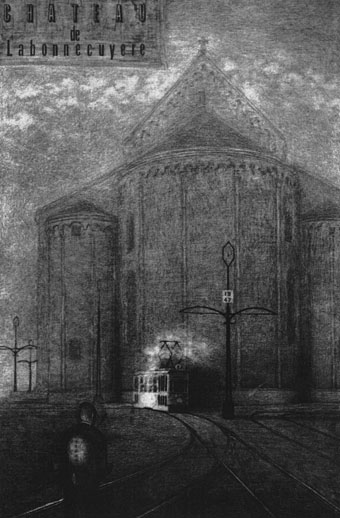
Chateau de Labonnecuyere (c. 1970s) by The Brothers Quay.
Trams are a recurrent feature in the early drawings of the Brothers Quay, and they’ve also appeared in the Quays’ earliest animated films and in some of their designs for the stage. I respond to this fetishisation on the deepest level having been born and raised on the Fylde coast of Lancashire, an area which was for many years the only place in Britain that kept its tramways after the rest of the country had given over the streets to buses and cars. Trams are so ingrained in my consciousness that I still dream about the trams of my childhood, many of which were rattling, streamlined things dating back to the 1930s. Manchester was tramless when I arrived in the city in 1982 but a few years later the council embarked on an ambitious and far-sighted scheme to return trams to the city’s streets. The first routes opened in 1991, and the network has been evolving ever since, pushing out of the centre along disused rail lines.
La Rue du Tramway (1938–1939) by Paul Delvaux.
The Quays aren’t alone in being attracted to this form of public transport. Trams haunt a certain type of oneiric European imagination, and I often wonder where the attraction lies. I think it’s something to do with their small scale and the way they remain bounded within the cities they serve. Trains have a romance and mythology of their own but are wide-ranging and far more common, as are buses whose presence on a city street is a reminder that the tram can be replaced. The Quays are Europhiles so they no doubt see the trams of the Continent as another feature of European city life that’s more arresting to American eyes. This post gathers some of the Quays’ uses together with other notable (and favourite) examples.
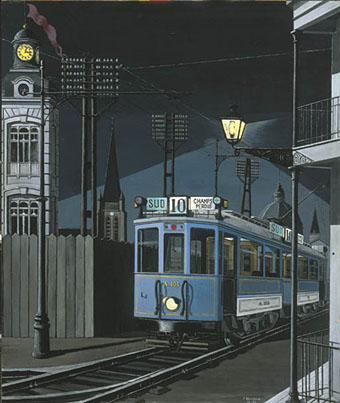
Tram nocturne (1950) by Paul Delvaux.
Several of the examples listed here are Belgian which either means that trams exercise the Belgian imagination more than that of other nations, or I happen to pay more attention to Belgian art. (Probably a little of both.) Paul Delvaux put trams into several paintings but seems to have been the only Surrealist to do so.
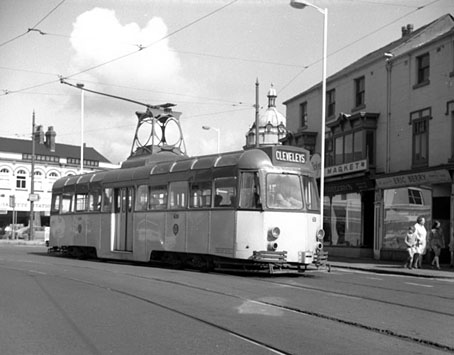
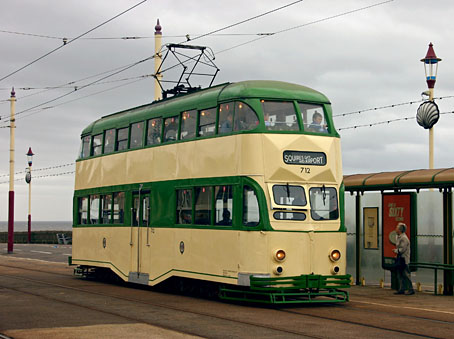
The trams that haunt my imagination are the cream-and-green vehicles that trundled for decades up and down the Fylde coast between Blackpool and Fleetwood. These machines used to run along the line at the end of the street I grew up in so there’s never been a day I can remember when I wasn’t aware of the tram—and of these vehicles in particular—as a viable mode of public transport. Looking at the websites of tram enthusiasts reveals the different names for each generation of Blackpool trams; so I now know that the bow-ended ones (which I always liked) are known as Brush Railcoaches, while the double-deckers are known as Balloons. None of these names were ever used by locals.
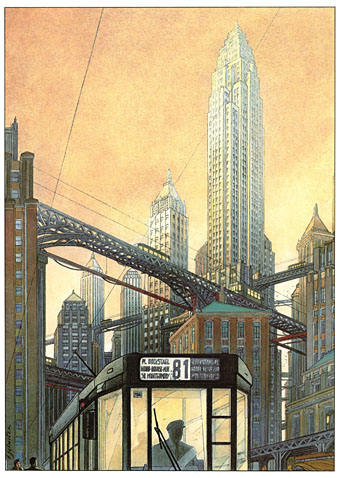
Back to Belgium, and the comics and illustrations drawn by the marvellous François Schuiten are filled with trams. I’ve written at length about the Obscure World mythos of Schuiten and Peeters so rather than repeat myself I’ll point to the mystery of Tram 81, a recurrent and unexplained presence in Schuiten’s work.
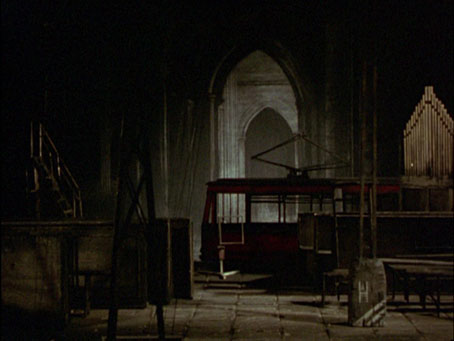
Nocturna Artificiala.
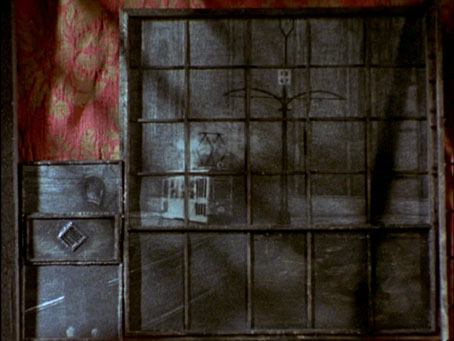
Nocturna Artificiala.
Trams for the Brothers Quay are the small European variety rather than the streetcars seen in some American cities. One of the brothers’ Black Drawings, Chateau de Labonnecuyere, features a pantographed vehicle that glides through their later animated films. The first of these, Nocturna Artificiala (1979), is a wordless masque involving the yearning relationship between the solitary puppet character and an empty, nocturnal tram. The film is an animated extension of Chateau de Labonnecuyere which not only features the drawing itself but also includes a unique moment where the tram glides through the vast cathedral seen in the background.
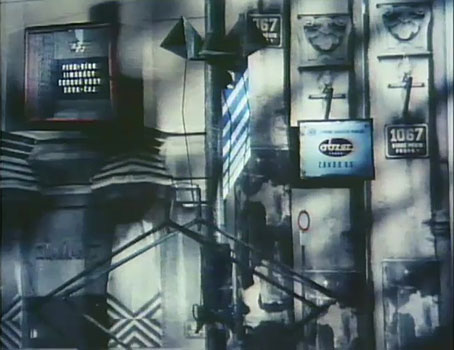
Leos Janacek: Intimate Excursions.
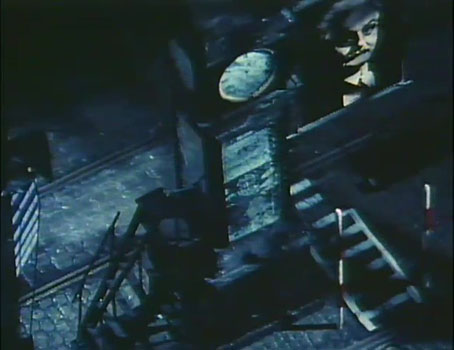
Leos Janacek: Intimate Excursions.
The power-line supports seen in Chateau de Labonnecuyere are a recurrent motif in the Quays’ works. They appear together with the Nocturna Artificiala tram in Leos Janacek: Intimate Excursions (1983), and may be glimpsed among the faded detritus in Street of Crocodiles (1986).
Avalon.
Avalon.
I don’t know what the Quays would make of the science-fiction scenario of Mamoru Oshii’s Avalon (2001) but the recurrent scenes of a nocturnal tram journey would probably appeal, especially since the tram in question is a Polish one. Mamoru Oshii is the director of many SF-oriented animations, not least The Ghost in the Shell (1995). Avalon was a surprise when it appeared (and then seemed to vanish all-too-quickly): a live-action drama concerning the players of a virtual reality game which can have lethal consequences for the contestants. The film was made in Poland with a Polish cast, and the scenes are heavily processed throughout, with everything given a sepia wash. Coming after The Matrix, Dark City et al, the virtual reality aspect wasn’t so much of a surprise but I loved the juxtaposition of a futuristic story in a run-down European setting. And the trams, of course. The dream-like atmosphere of the film’s mundane scenes brings everything back to Delvaux and his tram nocturnes.
I was going to add Tramway (1966) to this list, a short student film directed by Krzysztof Kieslowski, but it’s not especially mysterious. It’s worth a look if you like Kieslowski, however, and may be watched here. If anyone has suggestions for other mysterious trams then please leave a comment.
Elsewhere on { feuilleton }
• The Quay Brothers archive
Previously on { feuilleton }
• Paul Delvaux: The Sleepwalker of Saint-Idesbald

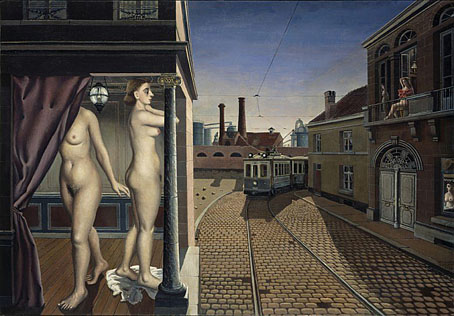
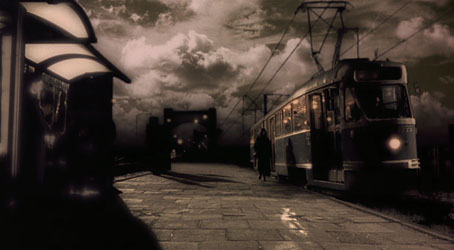
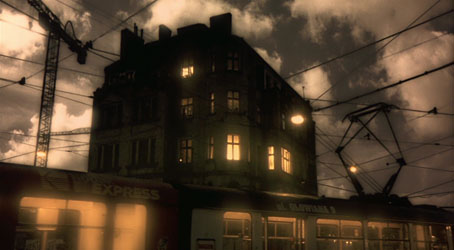
San Francisco’s livery was also cream and green and the F-Market line currently has a collection of vintage streetcars in service, many from around the world. They also have a large collection of the PCC cars which were the most popular during the mid century and they are run out in the livery of their original cities.
My favorite is the open-air Blackpool seaside streetcar.
You can see the operational fleet here:
http://www.streetcar.org/streetcars/
Here’s the gorgeous Blackpool:
http://www.streetcar.org/wp-content/uploads/sfmsr/uploads/photos/IMG_20131031_144927_511.jpg
The Toonerville Trolley cartoons always appealed to me:
https://www.youtube.com/watch?v=xhmqV9BnL_Q
Plus, of course:
https://www.youtube.com/watch?v=JWUed95MsXs
The spirit world train scene in Miyazaki’s Spirited Away is also very dreamlike and evocative.
https://www.youtube.com/watch?v=VbRmFSQYeac
Trams are the iconic transport of Melbourne where I live, and I must admit I pretty much take them for granted and they don’t haunt my dreams.
We have new trams, slightly older trams and very old trams running through the streets of Melbourne and by far my favourites are the old W Class trams which have been in service since 1923.
Wikipedia has a good article about Melbourne trams here:
https://en.wikipedia.org/wiki/Trams_in_Melbourne
A concert poster for the American Alt country artist Ryan Adams I have in my possession features an old W Class Tram.
There’s a picture of it here:
http://www.daymonart.com/shop.html (scroll to bottom of page)
Fascinating post John, thanks… I was excited to see Tram Nocturne as it jogged a memory of the Delvaux painting that graces the Penguin Modern Classics edition of Journey to the End of the Night, but I don’t think it qualifies here as it’s a train !
Something else that came to mind was a beautiful watercolour of a tram included in the 1977 book Unforgettable Fire: Drawings by Atomic Bomb Survivors, the painting augmented with some terrible details: the damage from the blast, and the tram conductor lying dead on the rails… (page 102, archive.org link: http://tinyurl.com/pabyfe6)
Finally, and I’m not sure again if we can include it, but there is the otherworldly tram seen on the desert planet in The Man Who Fell To Earth…
There’s a mysterious tram in this music video by The Audreys https://youtu.be/qQxPWT-ifyI
There are trams in my city, Edinburgh, but I — and a dozen others — have been opposed to them since their inception. Who knows, though? Perhaps an interesting piece of art can be born from them.
Also, I think Terry Gilliam’s film BRAZIL, has cube-shaped trams in its outlandish metropolitan setting.
Trams feature in quite a few of his Felix Kelly’s paintings:
http://3.bp.blogspot.com/-kvgrroRozNc/UKtvBryKn7I/AAAAAAAAdlg/NuNDwhrq8ZM/s1600/Felix+Kelly++(8).jpg
http://www.artnet.com/WebServices/images/ll00072lldtvxFFgVeECfDrCWvaHBOcUkJ/felix-kelly-triliths-and-trams.jpg
http://s497.photobucket.com/user/fffloating4/media/ShipTramHouse-web-full.jpg.html
I believe trams are mentioned in some of Lovecraft’s stories, Nyarlathotep comes to mind, and a tram conductor with one great tentacle for a face, but i don’t remember what story that is in.
That was The Thing in the Moonlight, an account of one of Lovecraft’s dreams which was published as a story (with bits added by another writer).
Thank you, Robin. By the way, John, the illustrations and art of this post are marvelous.
Thanks for the contributions, everyone.
Hecubot: I discovered the San Francisco tram when I was researching this post. A nice surprise, and more suited to San Francisco’s climate than Blackpool’s.
Anne: I recall a friend in Melbourne telling me about the trams there but don’t think I’d seen them before.
Wes: There’s a grey zone between trams and trains, especially the modern trams like our Manchester variety which are more of a light rail system since they operate at speed on old rail lines. That said, the one in The Man Who Fell to Earth I always take to be a train despite its small size. The scene where Newton is in the limo watching a passing train and says “The trains are so strange here,” dissolves to a flashback to the one on his home planet.
dexitroboper: That’s very Schuiten-like. Schuiten’s production designs for the Raoul Servais film, Taxandria, featured a similar combination of trams and giant cogs but little of that made it into the film.
Robin Davies: I definitely hadn’t seen any of Felix Kelly’s paintings before.
Back in the sixties I saw Felix Kelly’s wonderfully spooky monochrome artwork for Joseph Braddock’s book Haunted Houses:
https://www.google.com/search?q=joseph+braddock+felix+kelly+%22haunted+houses%22&lr=&source=lnms&tbm=isch&sa=X&ved=0ahUKEwici5SmraPQAhWFqxoKHa9pBLQQ_AUICCgB&biw=1280&bih=887
I recently read the excellent, well-illustrated book Fix: The Art and Life of Felix Kelly by Donald Bassett which shows the full range of his work.
https://www.amazon.co.uk/Fix-Art-Life-Felix-Kelly/dp/0957079656/ref=sr_1_1?ie=UTF8&qid=1478958428&sr=8-1&keywords=fix+the+life+and+art+of+felix+kelly
I’ll second the love for Melbourne trams. An iconic element of the city and a wonderfully extensive network. Australian painter John Brack painted a lovely mysterious tram in North Balwyn Tram Terminal. http://www.artnet.com/artists/john-brack/north-balwyn-tram-terminal-QtPIHeNCqfmG9xPEFnve8Q2
The dreamlike trams in the art of Felix Kelly come to mind – often the trams are marooned in unlikely locations as in the painting ‘The Tram and the Sand Dunes’…sometimes they appear in surreal industrial locations such as in ‘Tram and Coolers’. I’m hopeless at posting links & the like but these and further examples of mysterious trams, steamboats, and traction engines can be found in the highly attractive, illustrated biography ‘Fix’ by Donald Bassett.
Interesting post as always. It is only natural that trams are or rather were more prominent in Belgian art, since Belgium had a huge national tram system, that was at one time actually longer than the national railway system: buurtspoorwegen/chemins de fer vicinaux.
Interesting post. My reading of trams and their mystery would draw on your insight about the connection with trains. Both trams and trains run on rails, which takes them half-way to autonomy. That is, they have a kind of life or incipient vitality, akin to clockwork (a longstanding Weird fascination). With a car or bus, we’re always clearly aware that a human being is in charge. Ballard’s Crash is about the magnification of human will and autonomy / perversity, not (in the sense I’m interrogating) about an intrusion of mechanical alterity into the human world.
I don’t know whether Borges ever wrote about trams, but I can easily imagine it. Perhaps a story about an empty city where the trams still run, either self-directed or under the control of a hidden human agent.
And there are parallels with the longstanding Weird fascination with automata, Mechanical Turks, etc. There’s also, to my mind, a parallel with tides: another mechanical system that nevertheless retains a kind of life or incipient vitality, even to those who have undergone Weber’s Entzauberung (Disenchantment, i.e. loss of faith in the supernatural). Did Blackpool retain its trams partly because they were a kind of symbolic echo of the tide? Deep chthonic / thalassic forces may have been at work in the minds of town-planners…
Élagabal-23: I don’t know the exact reason for Blackpool keeping its trams but I’d guess a combination of their novelty value (the town is little more than an accumulation of tourist novelties) and convenience would explain it. They run a length of coastline providing a link between three resorts—Blackpool itself, Cleveleys and Fleetwood—and because they follow the coast they’re much easier for holidaymakers to immediately understand and use. Buses, by contrast, tend to detour through the back streets for the convenience of the locals; not only confusing but you miss the views of the sea. So they were too convenient to get rid of easily, and after a certain point were rare enough to be an attraction in themselves.
One thing about trams versus trains is that they appear easier to drive (although I don’t know how true this is). And some are driverless, if you include various light rail systems in the tram category. I’ve been on driverless light rail in London (the DLR), Paris and the airport at Washington DC which uses a rail shuttle between terminals.
As to Borges, Buenos Aires has an extensive tram system but I don’t recall JLB making great use of it:
https://en.wikipedia.org/wiki/Trams_in_Buenos_Aires